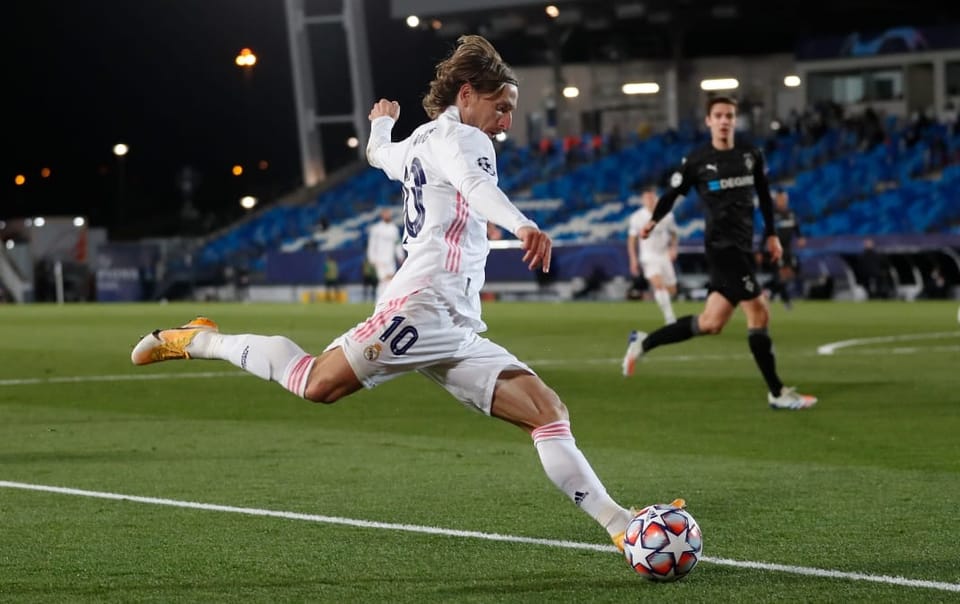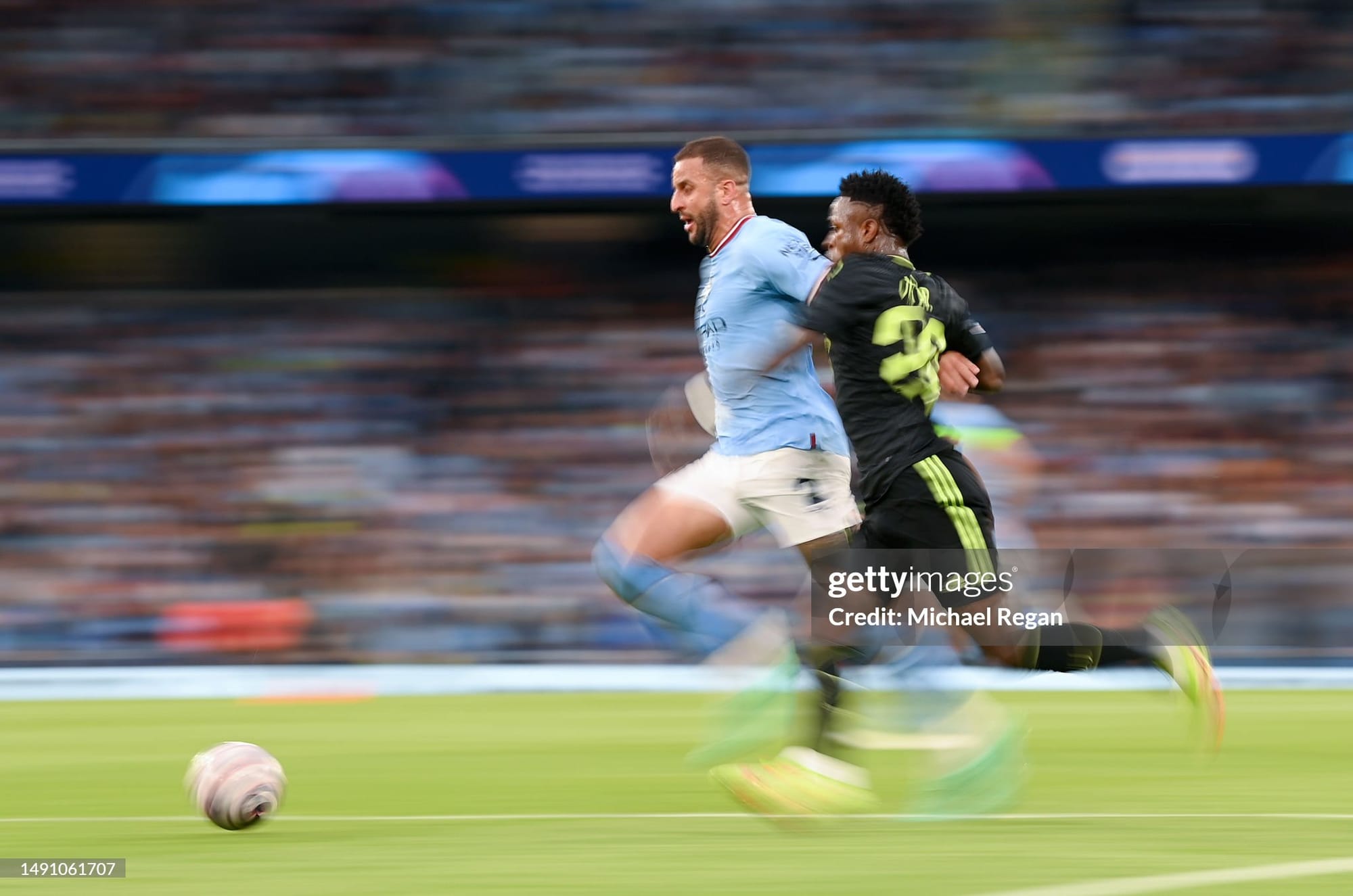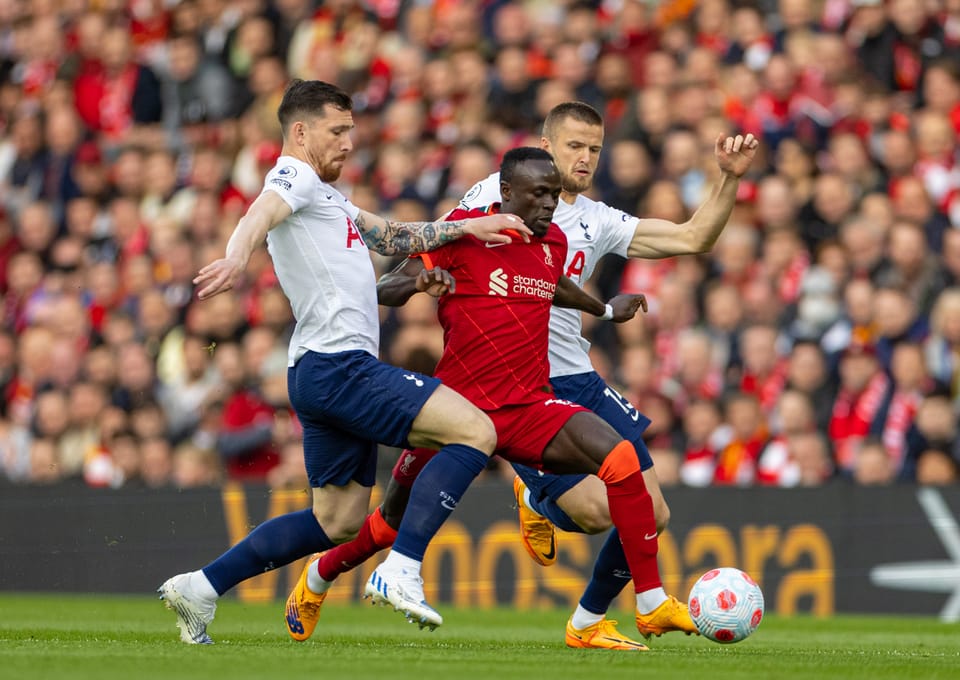Precision Play: Features of a Great Sho(o)t(er)
Some features of a great shot and great shooters
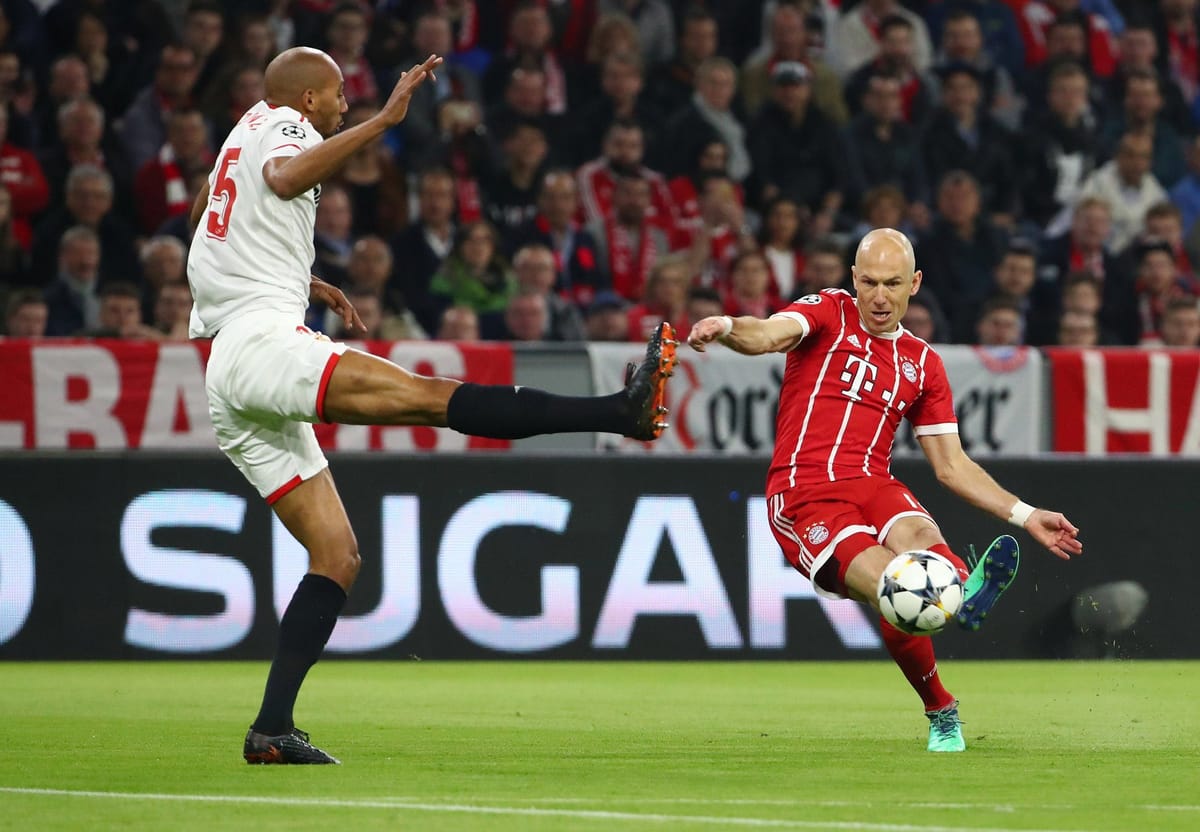
shot + shooter = sho(o)t(er)
Football is a weird sport. The ball is the single most important entity on the pitch, yet its interactions and relationship with players' boots are least discussed (at least in public spheres).
Expected goals (XG) is an robust baseline, but is anyone interested in:
- Why certain players are evidently better finishers than others?
- Why forwards who are seemingly strong shooters in one setting struggle in another?
- How to qualify a player's shooting potential across leagues?
- Acquiring a framework to guide targeted skill-improvement.
- The qualitative elements of shooting that differentiates elite players.
Welcome to Precision Play, a BallerzBantz series.
This essay will discuss a couple frameworks for assessing a sho(o)t(er), examine the mechanics of a powerful shot, and share some case-studies. As usual, the archive will be appended underneath each section.
Range: The Hallmark of Elite Goal-Scorers
The feature that truly typifies and insures great goal-scorers is their range when getting shots off. Range here is defined by the root question "How many different –":
- How many different ways can they create separation for a shot.
- How many different areas and situations do they manufacture shots from?
- What's their proficiency in each one?
- How many different shooting techniques do they have in their arsenal.
The reasoning is simple. Follow me.
Football is a low-scoring sport. Players receive few – maybe none – great shooting opportunities each game. Hence, they receive even fewer – maybe none – chances in their ideal spot.
Players who manage to log significant tallies across a campaign have many ideal spots, many ways of getting into their ideal spot, and/or many ways of deceiving the opposition goalie in their ideal spot.
It's just permutations. Qualifying each element of Range, though, is the trickier part. Let's dive in.
Creating Separation for Shots
Creating space to take a shot is crucial, and top scorers excel in both on-ball and off-ball movements:
- On Ball:
- Feints: Using body feints to mislead defenders about their intended direction.
- Directional Touches: Expertly controlling the ball to maneuver around opponents.
- Off the Dribble: Maintaining control and threatening the goal directly from dribbling.
- With Pressure Behind (Back to Goal): Managing to turn around or create space even when marked tightly.
- Off Ball:
- Double Movements: Deceptive movements that confuse defenders and create shooting opportunities.
- Strength to Hold Off Defenders: Using physical strength to maintain possession and position.
- Leap to Contest Aerials: Winning aerial duels to create heading opportunities.
- Straight Line Speed: Utilizing speed to outpace defenders and break into open spaces.
Areas and Situations for Manufacturing Shots
Elite scorers are adept at finding and exploiting shooting opportunities from a variety of positions on the field:
- Outside the Box, Without Pressure: Taking long-range shots where they have the space to line up their shot.
- Cutting In, Off Either Flank: Utilizing dribbles from the flanks to cut inside and shoot, often a favored move of wingers.
- From the Channel (CB-FB), Off Either Side: Exploiting the spaces between the center-back and full-back to take angled shots.
- Inside the 6-Yard Box, With Pressure: Exhibiting composure and quick reflexes to shoot amidst tight marking.
- Self-Made Shots (After Beating a Man): Demonstrating individual skill to beat a defender and create their own shooting opportunity.
Diverse Shot Techniques
The repertoire of shooting techniques a player possesses can significantly enhance their scoring potential [1]:
- Low, Driven Shot: Powerful ground shots that are hard for goalkeepers to reach (e.g., Casemiro, Rodri).
- Snap Release, Small Back-Lift: Quick shots with minimal preparation, catching goalkeepers off-guard (e.g., That Salah’s goal against Chelsea).
- Side Foot, Across Body, Off the Dribble: Precision shots while on the move, using the inside of the foot for accuracy (e.g., Mbappé, Kevin De Bruyne).
- Curled Shots with Power: Combining finesse with force to bend the ball around defenders and into the net (e.g., Anthony Martial).
- Headers: Utilizing aerial prowess to score from crosses and set-pieces.
Archive from December 25, 2023
[1] Test-Case spurred by @EarlTrapo
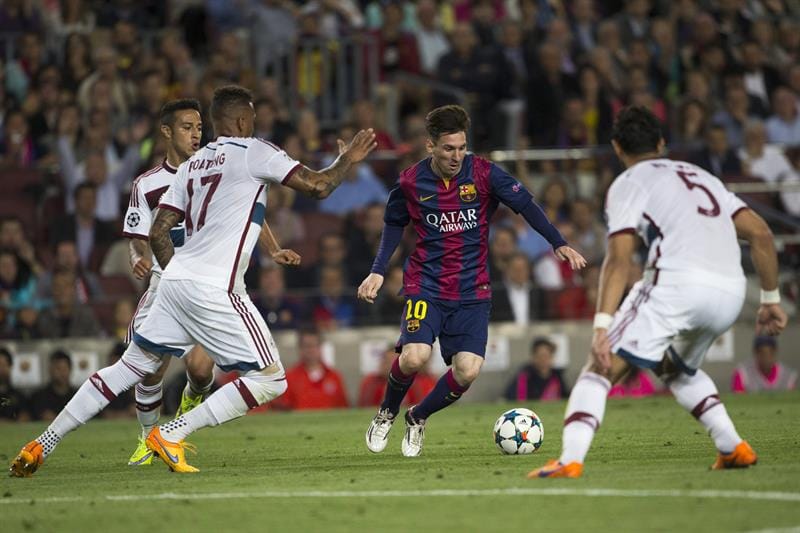
I've acquired a few paradigms to assess shot-making. The next two sections will discuss them.
A Holistic Assessment of Shot-Making
To understand a player’s effectiveness in front of goal, we must consider a few interconnected aspects:
- Decision Making: This involves when and where a player chooses to shoot, reflecting their tactical awareness and ability to read the game. Effective decision-making can often be more indicative of a player’s skill than the raw outcome of shots.
- Biomechanics: The physical mechanics of how a player strikes the ball—including their posture, foot placement, and striking technique—greatly influence the accuracy and power of the shot. Consistency in these mechanics is crucial for high performance.
- Spatial Dynamics: Evaluating whether a player can create shooting opportunities on their own through dynamism and agility, or whether they rely on their teammates to create these chances, is vital. This includes their ability to find or create space and time in the penalty area to take a shot.
Intrinsic vs. Extrinsic Factors
Understanding what aspects of a player’s shot-making ability are intrinsic and which are influenced by external factors is also critical:
- Intrinsic Factors: These include a player’s raw ability to strike the ball, make rapid decisions, and respond to spatial opportunities. Such skills are likely to transfer across different leagues and systems because they are rooted in individual capabilities.
- Extrinsic Factors: Elements such as the quality of opposition goalkeepers and defenders, as well as the amount of space and time a player is afforded in the opponent's box, can vary widely across different matches and leagues.
Archive from May 13, 2023 – my base-share for this one is wonky, so let's ignore it.
A Metric-based Framework to Assess Sho(o)t(er) Quality
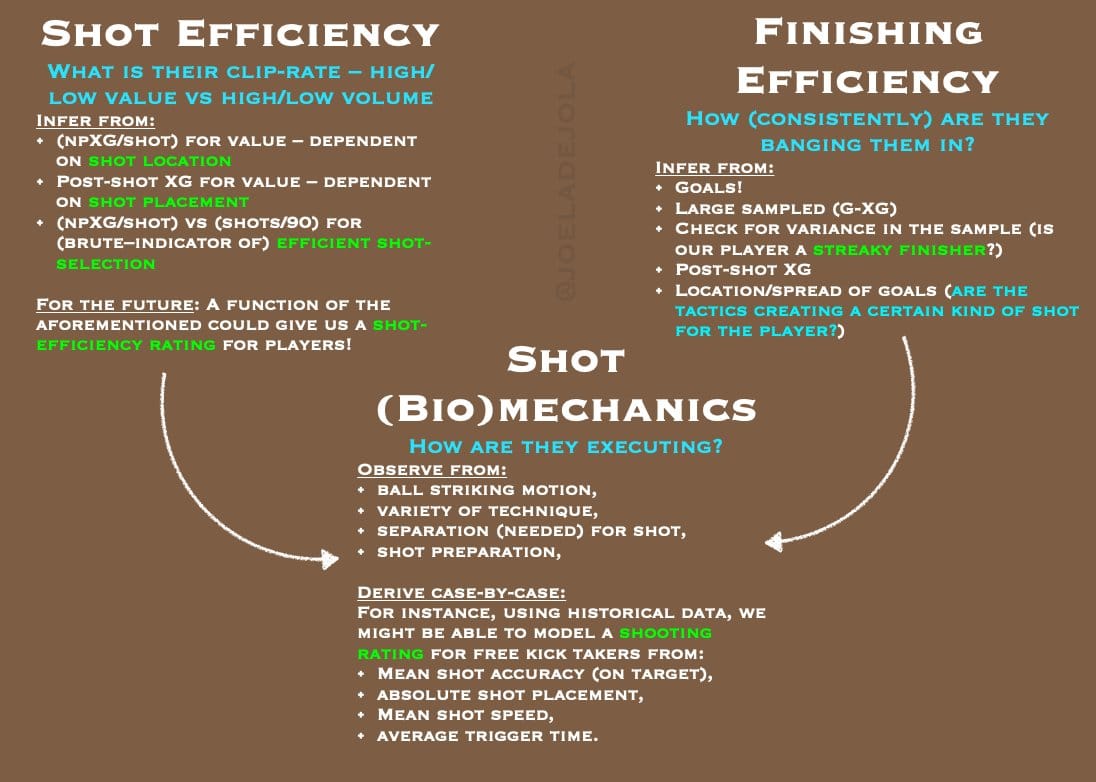
1. Shot Efficiency
The efficiency of a shot can be quantified by examining both its likelihood to result in a goal and the decision-making that led to it. Here are some key metrics to consider:
- Clip Rate: This refers to how often a player attempts shots that have a high probability of scoring (high value) versus those taken more frequently but with less chance of scoring (high volume). A balance between clip rate and volume can indicate a player's judgment and situational awareness on the pitch.
- xG per Shot: The expected goals (xG) metric per shot provides a value based on the shot’s likelihood of becoming a goal, taking into account factors like shot location and the game context. This helps in assessing whether a player is choosing good positions and times to shoot.
- Shots per 90 vs. Non-Penalty xG (NPxG) per 90: This comparison helps determine whether a player is just shooting often or actually creating meaningful chances. Players with a higher NPxG relative to their total shots are generally making smarter shooting decisions. I know this could just be the NPxG per shot metric – but I was adamant about maintaining the initial diagram I cooked up a year ago.
2. Finishing Efficiency
Finishing efficiency measures how well players convert their shooting opportunities into goals:
- Goals vs. Expected Goals (G-xG): This metric helps identify whether a player is an above-average finisher (scoring more goals than expected) or underperforming relative to the chances created.
- Variability in Finishing: Examining the variance in a player’s finishing over a large sample of shots can reveal if they are a streaky finisher or consistently reliable.
- Post-Shot xG: Considering the xG after the shot has been taken (which accounts for how well the shot was executed beyond just its location) can provide insights into a player’s shooting skill and composure.
- Tactical Shot Creation: Analyzing the types of shots a player takes can reveal much about the team's style and the roles assigned to the player. For instance, a player frequently positioned to take long-range shots might have different efficiency metrics than one primarily taking shots from inside the box.
3. Shot Biomechanics
The physical execution of a shot is critical and can be dissected through several biomechanical aspects:
- Ball Striking: Observing a player’s technique in striking the ball, such as foot placement, angle of approach, and body posture at the moment of contact, can indicate technical proficiency.
- Technique Variety: Players who can effectively use different shooting techniques (e.g., laces, inside of the foot, chips) are more adaptable and can be dangerous in varied scenarios.
- Preparation and Separation: The ability to create space for a shot and how a player prepares before taking a shot are crucial. Good separation from defenders allows for clearer shots, while effective preparation ensures better control and shot accuracy.
- Historical Performance Data: By analyzing historical shooting data, it’s possible to model and predict a player's shooting efficiency. Metrics like mean shot accuracy, shot placement, shot speed, and trigger time can be combined to develop a comprehensive shooting rating.
Archive from May 17, 2023
The Role of Variance in Assessing Shooting Efficiency
Understanding Variance in Shot Locations and Types
Variance in the context of football sho(o)t(ing) analysis not only refers to the differences in shot outcomes but to the diversity in shot types and locations a player is capable of handling. This diversity can significantly affect a player's overall effectiveness and adaptability on the field.
- Variance in Location: Analyzing variance in shot locations helps in understanding how a player performs under different spatial constraints. A player frequently taking low xG shots from the same angle or position may not necessarily be ineffective; rather, their specialized skill set might not be adequately captured by traditional metrics.
- Shot Type Variance: Including the types of shots a player takes—whether with the left foot, right foot, or a header—provides insight into their versatility. Players who can effectively use various shot types can adapt to different game situations, potentially increasing their threat level regardless of how play develops.
Test-case spurred by Guillaume (@guillaumevdwege):
"I'd also add variance in there. Not as a good/bad thing, but variance in location, left/right/header etc. A player may keep getting the same 0.08 xG chance but might not be good at finishing from that scenario (cross over CBs head from right side)"
Case-Study: Shot Preparation – Erling Haaland
The Pre-Execution
Shot-making transcends mere ball contact; it involves a sophisticated sequence of actions known as shot preparation or pre-execution or the 'set up' – turning a pass into shot opportunity.
Erling Haaland is one player who is great at this.
Shot-making involves more than just ball striking. The best shooters are also masterful at ‘setting up' shots: pre-execution.
— Joel A. A. (@joeladejola) June 16, 2023
Haaland here:
– Creates separation from marker, who follows
– Takes 'set' touch against their momentum
– Open stance so can swivel into right-footed shot pic.twitter.com/BKLBlec7CB
- Creating Separation: Haaland's ability to create separation from his marker is crucial. By drawing the defender and then making a sudden movement against their momentum, he opens up space for the shot – a testament to his understanding of spatial dynamics and defender behavior.
- Optimal Touch: The touch Haaland takes in preparation for the shot is deliberately set against the defender's momentum. This 'set' touch not only positions the ball ideally for the shot but also ensures that he maintains control.
- Open Stance: By maintaining an open stance and pivot on the back foot, Haaland is positioned to swivel efficiently into a right-footed shot. This stance allows for a quick and powerful rotation.
Visualizing and Executing in Real-Time
Haaland's ability to visualize and execute complex shot-prep sequences within split seconds under pressure is one thing that sets him apart as a great sho(o)t(er).
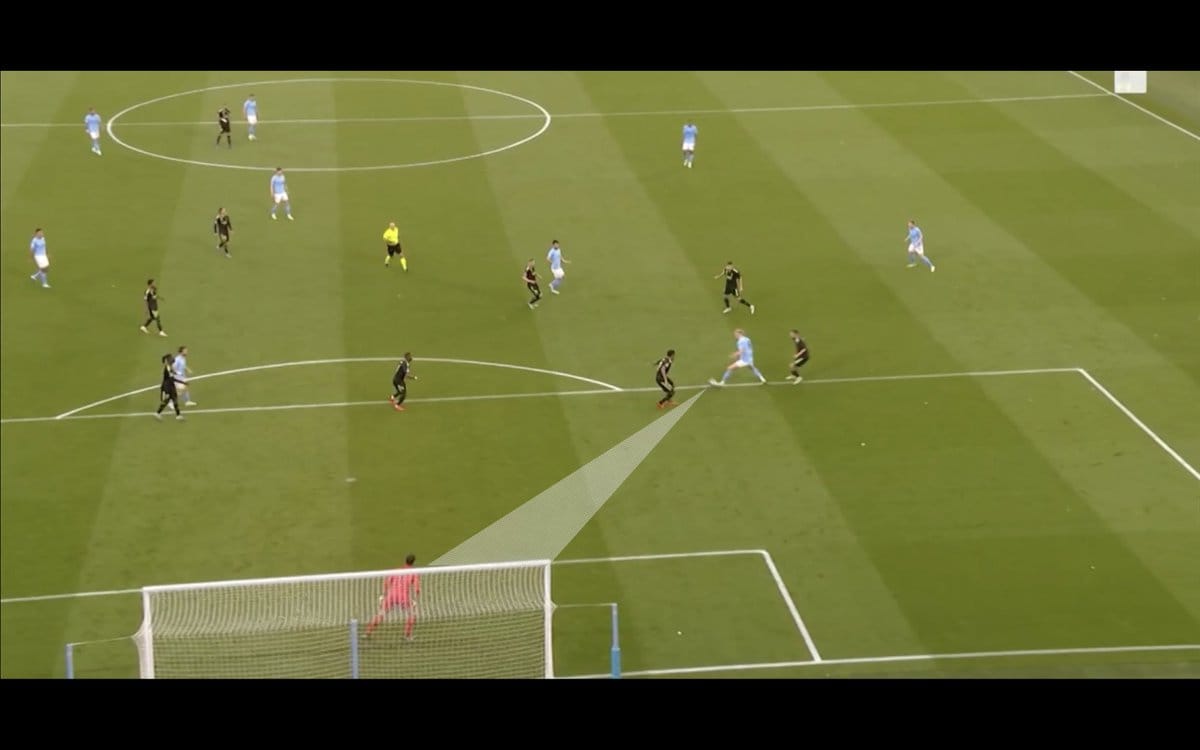
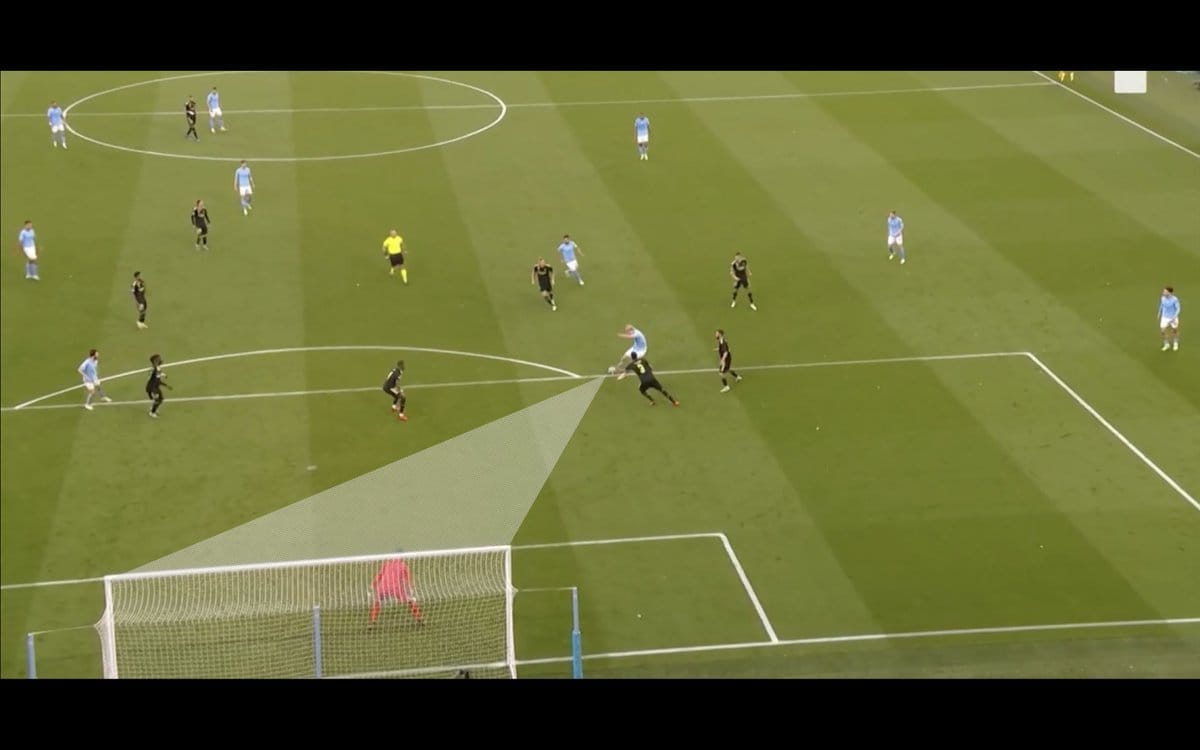
- Anticipation and Reaction: Even while tightly marked, Haaland anticipates the play's development, preparing his movements based on the expected actions of his marker. This foresight allows him to exploit brief moments of space effectively.
Biomechanics of Shooting
Understanding the biomechanics involved in shooting provides insights into the physical execution of a shot:
- Kinetic Chain: The movement involves three key joints: the hip, knee, and ankle, each contributing differently to the shot's power and accuracy.
- Hip: Generates the greatest moment, providing the bulk of power for the shot.
- Knee: The moment from the knee reaches its maximum at full extension, crucial for optimizing shot power.
- Ankle: Although contributing the least to power, the ankle is responsible for applying spin to the ball, affecting its trajectory and precision.
- Execution Details: In the moments leading up to and following contact with the ball, Haaland's steps and body alignment are critical. Small, stutter steps help him angle his body to maximize hip utilization. The placement of his non-shooting foot just centimeters from the ball ensures balance, while the extension and straightening of his shooting foot at contact maximize the power transferred to the ball.
Synergy with Teammates
Haaland’s interaction with his teammates, particularly in how he communicates his intentions and positions himself to receive passes, also plays a significant role. His indication to Ilkay Gundogan of where he wants the ball allows for a precise and strategically advantageous pass, giving Haaland an edge over his marker, Éder Militao, in this instance.
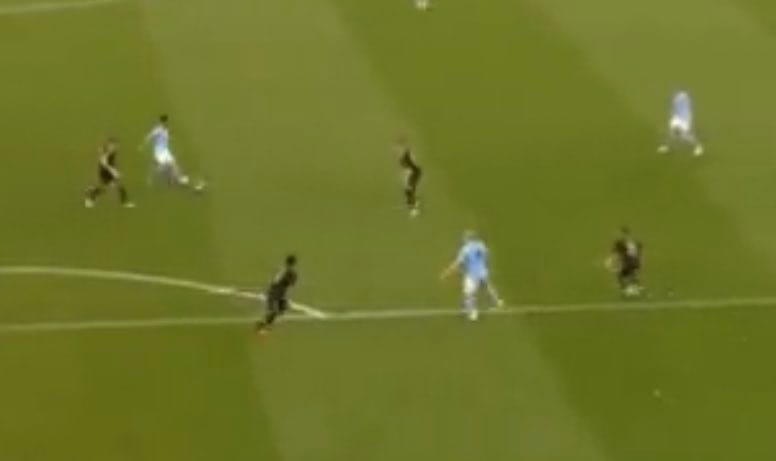
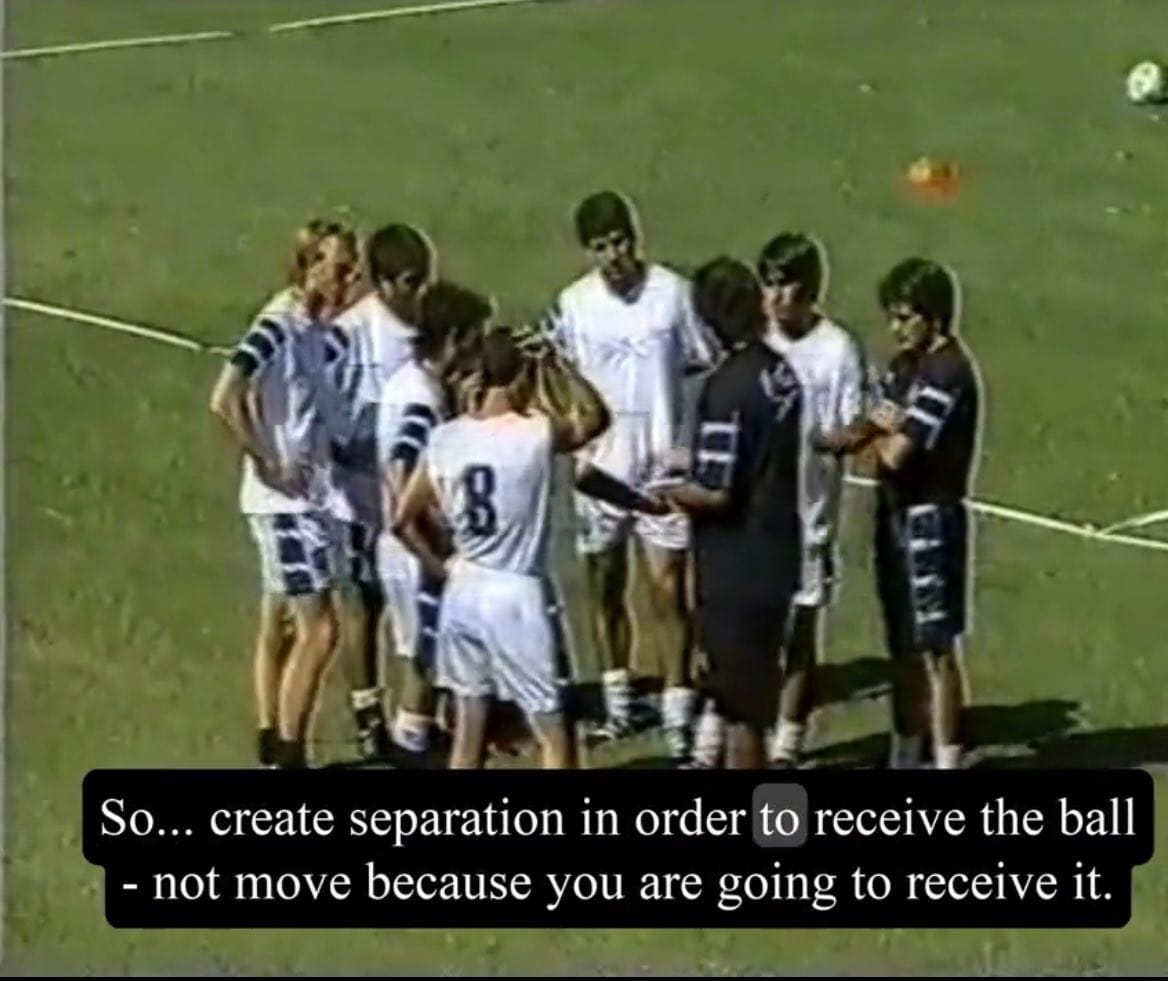
🗣️Create separation in order to make yourself an option, not because you are one.
— Dan F-M (@DanielFMPro) June 8, 2023
Working on Marcelo #Bielsa's Attacking Philosophy, & found that the introduction to this 2 minute clip of an 🇦🇷 training drill of his really does surmise the core build-up principles effectively🔍 pic.twitter.com/dnbRyIxo9A
Archive from June 16, 2023
Case Study: Carlos Teves – Mechanics of a Powerful Shot
Shooting in football is as much about precision and power as it is about timing and placement. First, look at Carlos Teves' goal in the quoted tweet, then see the critical breakdown below.
Golaço de Carlitos Tevez contra o México na Copa de 2010. 😳🤯
— Futebol Nostálgico! (@futnostalgico) November 15, 2023
Nostálgico!
pic.twitter.com/OuR3sofhOe
Key Components of Powerful Shot
- Planted Foot Placement: The position of the planted foot is crucial for stability and power. It should be close enough to the ball to provide leverage but also aligned properly to ensure balance and control. The planted foot should face towards the intended direction of the shot, which helps in channeling the body’s momentum effectively towards the target.
- Toe Direction: The orientation of the toe, specifically of the planted foot, plays a significant role in dictating the ball's trajectory. Pointing the toe towards the intended direction ensures that the body follows through along the correct path, enhancing the accuracy of the shot.
- Leg Position at Contact: The shooting leg must be erect at the moment of contact with the ball. This position allows for maximum force transfer as it ensures that the leg is at full extension, harnessing the power generated from the swing of the leg from the hip.
- Arm Position: To counterbalance the considerable momentum generated during a powerful shot, the shooter’s opposite arm swings across the body. This action not only helps in maintaining balance but also adds to the body’s rotational force, augmenting the power of the shot.
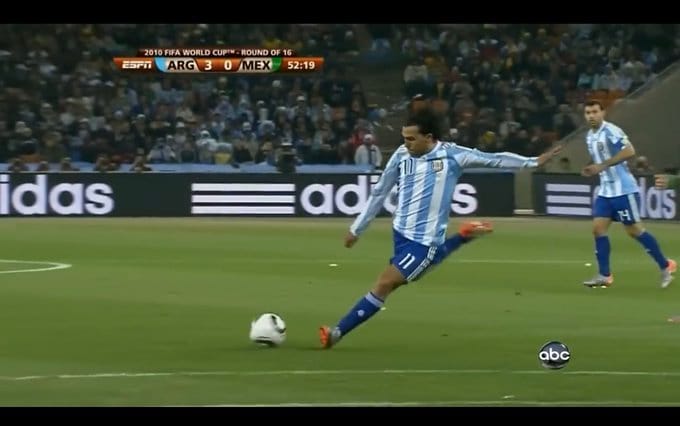
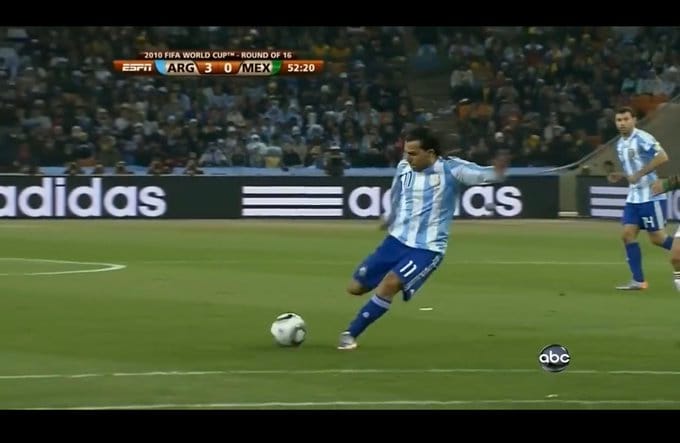
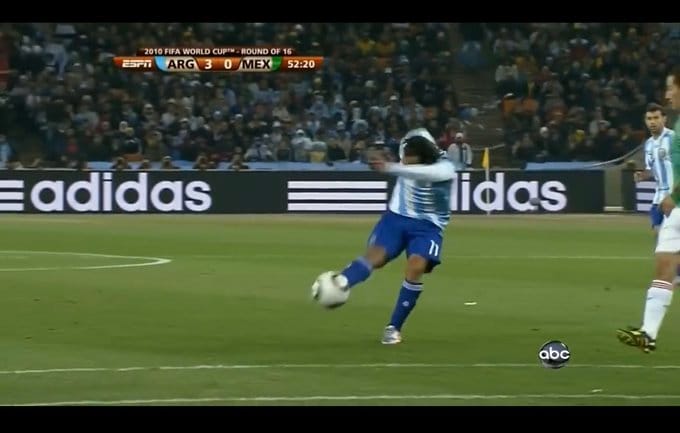
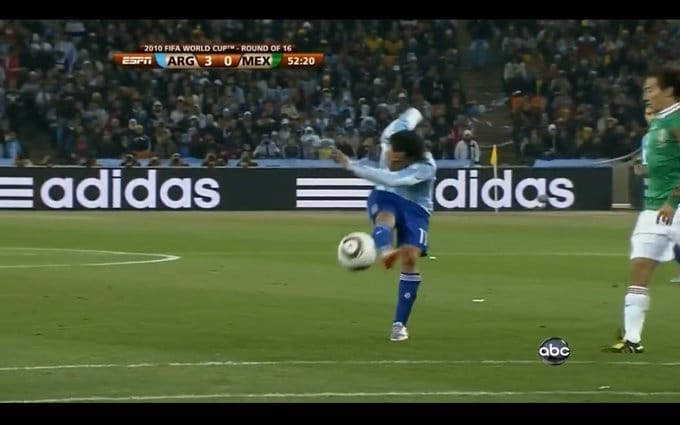
Analyzing the Shot Sequence
In the provided sequence, we observe the shooter in a series of frames that highlight the execution of these mechanics. From the initial approach where the planted foot is set, through the leg's extension, to the final follow-through, each component is executed with precision.
- First Frame: The shooter prepares to strike, setting the planted foot firmly on the ground, toes pointed directly at the target. This preparation is crucial as it sets the foundation for the shot.
- Second Frame: As the shooting leg comes into contact with the ball, it is fully extended, ensuring that all the kinetic energy is transferred into the shot. The toe of the planted foot remains directed towards the goal, ensuring the shot’s direction is maintained.
- Third Frame: Post-contact, the shooter’s leg follows through, maintaining its erect position, which helps in maximizing the shot's velocity. The arm swings across the body, aiding in balancing the significant rotational force generated during the shot.
Archive from November 18, 2023
Thinking Ahead: Quantifying (the Ability to Create) Shooting Angles
[In ⚽️]
— Joel A. A. (@joeladejola) December 6, 2023
Quantitatively:
We’ve solved receptions.
We’ve solved shooting.
Have we solved how (well) different players manufacture angles for shots once ⚽️ is under their control?
— the (threat) difference between Haaland or Martial receiving an identical ground pass in the box.
State of Play
State of Play – Football Analytics
Here's where football analytics is at – the shooting problems we've solved:
- Receptions: Through detailed positional data and event tracking, we've come to understand how players receive passes, where on the pitch receptions are most effective, and how these contribute to subsequent play development.
- Separation: Nothing
- Shooting: Advanced metrics like expected goals (xG) have revolutionized our understanding of shooting by quantifying the probability of scoring from various positions and scenarios.
It's obvious where the gap is.
While we understand where shots are taken and their likelihood of scoring, the process by which players maneuver to create these shooting opportunities is less quantified. How do players like Erling Haaland and Anthony Martial differ in their ability to manipulate space and angles once they control the ball in identical game situations?
Developing metrics that can measure how players manufacture shooting angles — considering factors like defender positioning, comparing first-contact vs shooting-contact, and ball control — could provide new insights into attacking effectiveness.
Other Curiosities:
- Rashford and Abraham, Why are they Good Finishers? [YouTube] by @SebC__
- Soccer Kicking Biomechanics, Dr Neal Smith [YouTube]
What Next?
If you enjoyed this, consider subscribing to BallerzBantz, following us on Twitter, and sharing this with someone.
Join us to stay ahead and contribute to this burgeoning community.
Who is the Writer?
Joel A. Adejola is an undergraduate at the University of Kansas (KU), studying Engineering and Philosophy.
